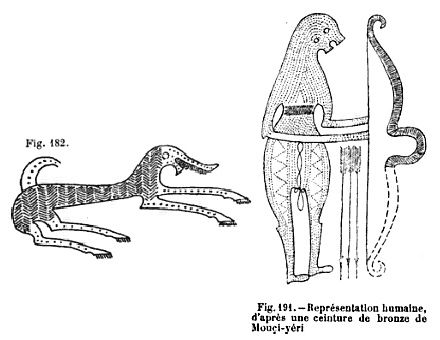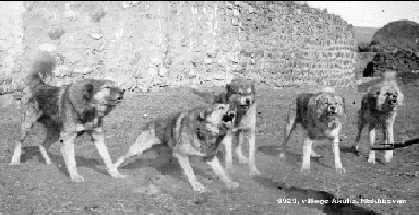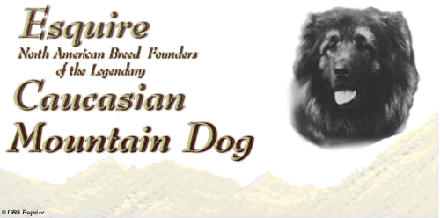| |
Family & Property Guards Through the Ages
From the Caucasus - 3000 years ago
On a bronze mounting, found at Mouci-yeri in the Armenian Caucasus and dating to about 1000 BCE, a dog depicted next to his owner. From other images on the same piece, the wavy hatches should be considered darker and long fur and the dots as lighter and shorter fur. Note tail shape, size, emphasis on flues/teeth and absence of any depiction of ears.
The human figure is best interpreted as a guard or warrior in a position of defense - the great longbow being more suited to warfare than hunting and the placement of arrows at-the-ready in the ground not being usual when hunting. An English archer defending against French knights at Agincourt would have been similarly arrayed.
|

|
European Visitors to the Caucasus in the 1800's
The following quotes are taken from travellers in the mountain regions of the Caucasus - not the transitional or steppe-like lands that lie both to the north and south of the mountain range itself. The absence of any description of large livestock herds (and of dogs guarding them) is noticable. Instead there are essentially constant references to village and property guard dogs of great size and determination - defending sometimes against the wolf but more often against two-legged intruders.
It is mostly from this stock of big, heavy-boned, people (friend/foe) oriented, stable, phlegmatic (not over-active), judgment-intensive, courageous "bear-type" mountain dogs that Soviet cynologists later selected to form the modern "Kavkazets".
"[At the villages,] there are many dogs, typically of a breed of large wolf-dog [perhaps "волводов" in Russian.] ..... The Cherkes generally have dogs at their homes .... [While riding about 1 km from a village,] since it was night when we came near, the dogs of the place began to come at us; our Cossacks, quite concerned, told us to remain calm, and to have our horses move as gently as possible away from them."
Voyage au mont Caucase et en Georgie
Julius v. Klaproth - 1823
"Before finishing my observations on Sukhumi [now in Abkhazia], I will say that practices in this place are such as those in a besieged town. The outer posts, placed at a 100 paces from the town walls, .... are brought in at dusk and the gates are firmly shut. Then a few dogs are put outside the gates, and serve as a troop of guards and provide exterior security. They [also] precede parties that cut wood and forage, and they advertise by their cries any ambushes that they might perceive."
Voyage dans la Russie méridionale, et particulièrement dans les provinces situées au-delà du Caucase
Jean-François Gamba - 1826
"[We were] assailed at each village by the enormous Tatar-dogs" .... "furious village guard dogs which scented the approach of any stranger" .... "[We were confronted by] the enormous Tatar-dogs which guarded the women, children and priests of the town".
Voyage autour du Caucase, chez les Tcherkesses et les Abkhases
Frédéric du Bois de Montperreux - 1840
"[Approaching with a troop of Cossacks to a Terek-family outpost in south Daghestan], we heard a brief barking, and then saw four of the large valliant dogs surge forth from the trenchworks. These vigilant sentinnels charged at us. Then, raising their noses and sniffing the air two or three times to scent us, their examination was completed. Followed by us, these noble animals spontaneously returned and re-entered the trenchworks. .... We interviewed the old sergant who commanded the small post of 15 men. I complimented him and asked him about the beautiful dogs. «They watch, he told me, and, especially at night, they stand round the crest of the trenchworks - at the least suspicious thing, they let us know.
» "
Noted later were the same kind of dogs guarding the still-occupied homes of semi-abandoned Sardarabad, near Yerevan in modern Armenia.
Lettres sur le Caucase et la Crimée
Florent Gille - 1859
"I was startled by a terrific din, and, turning round, saw the faithful Paul in sore danger from a combined attack of three unprincipled dogs. One huge brute had tried to pin him, and had been driven off with stones; but the moment after two other dogs came furiously out upon him, and while he was making fight against them the original aggressor stole up behind him, intending, with considerable cunning, to take him in the rear while he was defending himself from the onslaught in front, .... in truth Paul was in considerable danger, and at different times so were others of us from the Caucasian dogs, jackal-like brutes, not resembling any breed known in England. Exceedingly savage, and with even more than the usual hatred of dogs for strangers, they have a good deal of the cunning of the wild beast. Constantly, when going into or out of a village, or approaching a shepherd's camp, the traveller is set upon by three or four of these ill-conditioned hounds, who often make a combined attack on him with considerable craft. He cannot shoot them, as to do so might breed a serious quarrel with the villagers. .... Another vice almost as trying as the desire to flesh themselves on foreigners have the Caucasian dogs - they bark all night long. ....
There were cattle grazing on some of the hill-sides, and this told of peaceful human occupation and of settled life in this seeming wilderness. Soon there was still better evidence of this, for we came to a farmhouse whence issued the inhabitants, after we had as usual battled with jackal-like dogs."
The Frosty Caucasus: an account of a walk through part of the range and of an ascent of Elbruz
Florence Craufurd Grove - 1875
"When returning to the outpost, we were assailed by the large dogs of the Armenian villagers, truely ferocious beasts against which we had great diffiuclty to defend ourselves; it is the same at all the villages in the Caucasus, and one can get in terrible trouble by killing any of these molossers; one day we were forced to shoot twice into a group of these dogs which was attacking us; moments later all the population of the village fell upon us. These creatures did not back off until they saw that we meant to treat them all, dog and human, as they merited [i.e. by shooting them]."
Le Caucase et la Perse
Ernest Orsolle - 1885
"The dog [of the Caucasus], whose [historical] presence is noted by skeletal remains and by iconography, was, if we believe this evidence, of great size, with cropped ears and with a large standing tail. These characteristics are now those of the dogs of the shepherds of the Armenian mountains."
Mission scientifique au Caucase: études archéologiques & historiques
Jacques Morgan - France, Ministère de l'éducation nationale - 1889
"We were a long way from the top of the pass, and it was quite evident the party could not pass the night at Burj. .... Ma'amed knew of a place frequented by shepherds where there was good pasturage for the horses, .... so leaving the path we rode to the left for a short distance, and soon learnt, from a savage attack made on us by half a dozen ferocious dogs, that we were at a shepherds' encampment. Three or four of these came rushing up armed with long sticks, and drove the dogs away, at the same time warning us to be careful of not going near them. The shepherds .... bivouac is called Nour, which I was informed meant a place where there is always water. It lies on the northern edge of a steep mountain ridge, about a thousand feet below the summit of the pass, which lay to the north-east. .... For arms they had of course their kinjals and a couple of native flint guns, which might serve to frighten an enemy if the powder was dry enough to go off. More formidable-looking than the guns were the long, thick sticks they carried, which they know well how to use.
Two or three men from an adjoining bivouac had come to pay us a visit. When it was time to return they made a sudden bolt, and dashed off at full speed, swinging their staves behind them to keep off the dogs; for, curiously enough, the dogs of our bivouac attacked them as fiercely as they did us. As soon as they noticed the shepherds bolting they followed them with the greatest fury, animated apparently with the worst intentions, but were unable to do them any harm. When this interlude was over, the dogs of their own accord stationed themselves at intervals round the bivouac, and kept watch at a distance of about a hundred yards from the centre. They were great ugly shaggy brutes to look at, but made admirable sentries. Before nightfall the sheep and calves that had been grazing on the mountain were driven within the zone protected by the dogs, and then the work of the day was at an end."
A trip through the eastern Caucasus
John Abercromby - 1889
"At a little distance the maidens of the place, adorned with necklaces of sea-shells, pieces of amber and many-patterned beads, clad in bright red robes and crowned with turbans .... ranged in a circle, pass the time in songs and dances. Smaller children, more or less naked, play with sticks and rags, or carry home on wooden platters portions of the ox that has just been slaughtered in the churchyard, pursued by large, wolf-like dogs, disposed to claim prematurely their share in the harvest-feast."
The Exploration of the Caucasus
Douglas William Freshfield - 1896
Into the Early 1900's ....
"There are not many places of interest round Tiflis [capital of modern Georgia] .... once the town is left behind one is in a poorly cultivated, broad, almost deserted valley between bare, rocky mountains. Occasionally one meets with encampments of gipsies or nomad mountaineers living in tents; unkempt men and women of the strangest types, attired in rags and patches of bright colour - survivals of the earliest stages of human development - squat on the ground attending to domestic duties; they are protected by shaggy dogs of enormous size and unparalleled ferocity, which no stranger can approach with impunity."
Fire and Sword in the Caucasus
Luigi Villari - 1906
"The dogs there [at Sukhumi, now in Abkhazia] are ferocious, as they are throughout the Caucasus. .... These large fawn-gray dogs of the villagers are always very dangerous beasts."
La côte d'Azur russe : Voyage en Russie méridionaleā€ˇ
Èdouard-Alfred Martel - 1908
"I had turned aside from the track to climb the side of a wooded hill near Stolovy Mountain. I had an idea that I might find a sheltered spot among the trees. I had not slept out before, and I feared to be found sleeping by any of the natives. I was not a rich prey for the robber, but in Russia they steal even one's clothes. There are many stories current in Vladikavkaz which must have a certain amount of foundation in truth. .... I had one moment of thrills this day. I had just emerged from a wood on to a grassy ridge of the mountain when I saw a shepherd's camping-ground guarded by dogs. The dogs saw me at the same moment, and all four came tearing along towards me. They were something between bull-dogs and mastiffs, and I had a good mind to climb a tree at once. But something restrained me; the dogs were perhaps too close; I had a cudgel in my hand, I grasped it firmly and awaited the onslaught. Every dog's eye was riveted on my stick, and they all slackened speed suddenly and skirmished to bite at my heels or dart under my arm. .... Many a man in my position might have fired a revolver and then the owners of the dogs would have declared war. I recalled the words of Freshfield, the mountaineer, concerning such positions: 'It is judicious to avoid petty wrangles with Ossetes and to tranquillise their sheep-dogs with ice-axes rather than to dismiss them with firearms.'
A shepherd came up to me in a few minutes and began the common series of interrogations - Where do you come from? Where are you going to? Why? What are you—a Russian? I answered him very vaguely that I was going to Dalin-Dalin, a little village near by, on business, and that I was not a Russian. He said - 'You ought to be afraid to go about in these parts - many men get killed - a mate of mine was murdered near here last month.'"
A vagabond in the Caucasus
Stephen Graham - 1911
"Crossing the foaming Terek we tried to walk through a little village guarded by the efficacious dogs peculiar to the Caucasus. They were wild and fierce."
Casuals in the Caucasus: the diary of a sporting holiday
Agnès Herbert - 1912
"I never saw German Shepherd Dogs in the Caucasus countries; this most likely results from the fact that the Caucasian shepherds have a far better breed to guard their livestock. .... The height at withers is 70-75cm [28-30"], some males of the Armenian highlands are even 80cm [32"] tall. .... The Kurds at Mount Ararat warned my travel companions not to get close to their dogs. .... With reference to geographic dissemination, verbal descriptions about shepherd dogs of the Caucasus are definitely mountain dogs. They are very seldom met in the plains, at least not in a pedigreed existence. Between 1000 and 2300 meters (3000 -6900 ft) above sea level you see them with all alpine shepherds. .... At the coast of the Black Sea, Russian dog enthusiasts told me the largest number and most beautiful shepherd dogs can be found in the Armenian highlands. I was able to confirm this later. I saw extremely nice pedigreed dogs in the Ararat region and in Jelenovka at the Goktscha lake (Sevan's old name), which is almost 2000 meters above sea level. Some individuals were the size of a strong St. Bernard or Leonberger."
A Study of the Domesticates of the Caucasus Region
Dr. Conrad Keller - 1913

Guardian Dogs in the Armenian Caucasus - 1929
(Photo by courtesy of Tigran Nazarian, Armenia)
|
(c)2009 Stacey Kubyn - Esquire Caucasians - All Rights Reserved
|



